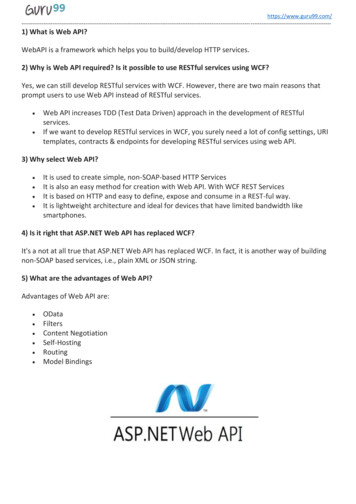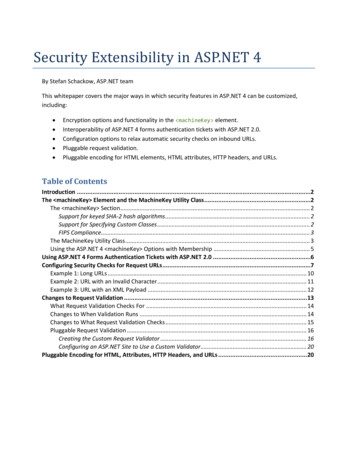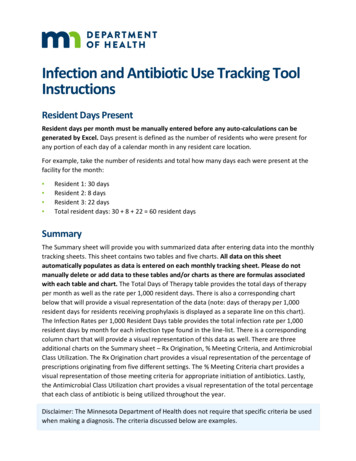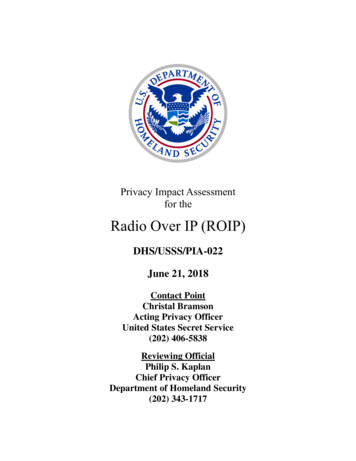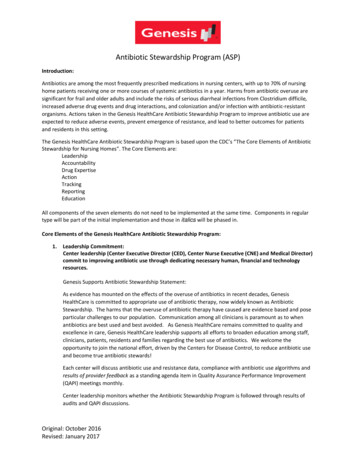
Transcription
Antibiotic Stewardship Program (ASP)Introduction:Antibiotics are among the most frequently prescribed medications in nursing centers, with up to 70% of nursinghome patients receiving one or more courses of systemic antibiotics in a year. Harms from antibiotic overuse aresignificant for frail and older adults and include the risks of serious diarrheal infections from Clostridium difficile,increased adverse drug events and drug interactions, and colonization and/or infection with antibiotic-resistantorganisms. Actions taken in the Genesis HealthCare Antibiotic Stewardship Program to improve antibiotic use areexpected to reduce adverse events, prevent emergence of resistance, and lead to better outcomes for patientsand residents in this setting.The Genesis HealthCare Antibiotic Stewardship Program is based upon the CDC’s “The Core Elements of AntibioticStewardship for Nursing Homes”. The Core Elements are:LeadershipAccountabilityDrug ExpertiseActionTrackingReportingEducationAll components of the seven elements do not need to be implemented at the same time. Components in regulartype will be part of the initial implementation and those in italics will be phased in.Core Elements of the Genesis HealthCare Antibiotic Stewardship Program:1.Leadership Commitment:Center leadership (Center Executive Director (CED), Center Nurse Executive (CNE) and Medical Director)commit to improving antibiotic use through dedicating necessary human, financial and technologyresources.Genesis Supports Antibiotic Stewardship Statement:As evidence has mounted on the effects of the overuse of antibiotics in recent decades, GenesisHealthCare is committed to appropriate use of antibiotic therapy, now widely known as AntibioticStewardship. The harms that the overuse of antibiotic therapy have caused are evidence based and poseparticular challenges to our population. Communication among all clinicians is paramount as to whenantibiotics are best used and best avoided. As Genesis HealthCare remains committed to quality andexcellence in care, Genesis HealthCare leadership supports all efforts to broaden education among staff,clinicians, patients, residents and families regarding the best use of antibiotics. We welcome theopportunity to join the national effort, driven by the Centers for Disease Control, to reduce antibiotic useand become true antibiotic stewards!Each center will discuss antibiotic use and resistance data, compliance with antibiotic use algorithms andresults of provider feedback as a standing agenda item in Quality Assurance Performance Improvement(QAPI) meetings monthly.Center leadership monitors whether the Antibiotic Stewardship Program is followed through results ofaudits and QAPI discussions.Original: October 2016Revised: January 2017
Antibiotic Stewardship Program (ASP)2.Accountability:Identify individuals in the center who will be accountable for the antibiotic stewardship activities.While the Medical Director and Center Nurse Executive are responsible for implementation andmonitoring of the Antibiotic Stewardship Program, other members of the inter-professional team alsoplay important roles.Medical DirectorCommunicates expectations to providers regarding antibiotic prescribing practicesActs as resource for nurses, as needed, when communicating with providersLeads discussion of antibiotic use at QAPI meetingsProvides and ensures documentation of education given to prescribers (MD, NP, PA) regardingantibiotic stewardship, antibiotic use algorithms and policies to improve antibiotic useReviews available Center Antibiotic Reporting to: Oversee adherence to antibiotic prescribing practices Evaluate antibiotic use data and ensure best practices (e.g., the right drug at the rightdose for the right amount of time) are followedProvidersAdhere to expectations and guidelines of the ASPOffer thoughtful diagnosis of infections and judicious use of antibiotics when necessary –incorporates use of antibiogram in antibiotic selectionProvide appropriate support of clinical staff in use of ASP tools – assists in educating nurses andfrontline care providers in evaluation and follow up careDocument clinical rationale to support the use of antibiotics, especially if using outside ofalgorithm guidelinesEnsure orders for antibiotics contain the dose, duration and indication for useDocument conversations with patient and their patient representative regarding thecurrent medical treatment plan and the appropriate use of antibioticsOriginal: October 2016Revised: January 2017
Antibiotic Stewardship Program (ASP)Center Nurse ExecutiveEnsures that nursing staff evaluate, monitor and communicate changes in a patient’s conditionthat could impact the need for antibioticsWorks with Unit Managers/Supervisors to ensure that SBAR is utilized by nurses to communicaterelevant clinical data to providers, and that nursing evaluations of patient clinical status andpatient response to treatment are documented in PCCUses her/his influence as a nurse leader to help ensure antibiotics are prescribed only whenappropriateEducates Consultant Pharmacist regarding the center’s Antibiotic Stewardship Program, policiesand antibiotic use algorithms (CNE designee may facilitate education)Collaborates with the center’s admission team to ensure appropriate information regardinginfection type and antibiotic duration is obtained for new admissionsCollaborates with providers and Medical Director regarding patient clinical status and alternativetreatment options (i.e.: watchful waiting) if patient does not meet criteria for antibiotic useNurse Practice Educator/Staff Development CoordinatorEducates front line nursing staff and other members of the inter-professional team (i.e.; rehab,recreation and social services) about the importance of antibiotic stewardship and explainsprogram/policies/practices in place to improve antibiotic useDocuments and tracks education provided to Nursing Staff (RN, LPN, CNA)Documentation of other IPT members will be tracked by their respective department headsFront-Line Nursing StaffPlay a key role in the decision making process for starting an antibiotic. The nurses will: Communicate patient status to providers in a timely manner utilizing SBARDiscuss with providers if the patient meets criteria for antibiotic use or if alternativemeasures for treatment are warranted (i.e.; watchful waiting, increased hydration)Document in the medical record education regarding antibiotic use and antibiotic stewardshipprovided to the patient and their patient representative Original: October 2016Revised: January 2017Contact providers for reassessment (time-out) of the ongoing need for and choice of anantibiotic once more data is available including: clinical response
Antibiotic Stewardship Program (ASP) additional diagnostic informationalternate explanations for the status change which prompted the antibioticstartConsultant PharmacistDuring monthly Medication Regimen Review (MRR): Reviews antibiotic courses for appropriateness of administration and/or indication Reviews microbiology culture data to assess and guide antibiotic selection for patient Monitors for adverse drug events from antibioticsAssists with monitoring provider compliance with proper documentation of antibiotic orders –dose, duration and indication (in order and pharmacy label), and antibiotic use algorithmsMay provide education to nurses on provider considerations when selecting antibiotics (i.e.; forUTI, IV vs PO)Participates in quarterly QAPI - reporting on center’s antibiotic utilizationInfection PreventionistMonitors and supports antibiotic stewardship activities through rounds, review of providerorders, PCC documentation and available PCC/pharmacy/lab reportsTracks antibiotic starts – through use of line listings and pharmacy reportsReviews antibiotic resistance patterns: Monitors HAI MDROs on Monthly Line Listings and Infection Control Report looking forincreased rates and/or trendsCompares with center antibiogram to look for commonalitiesLaboratoryProvides antibiograms to centersAlerts center if certain antibiotic resistant organisms are identified (i.e.: CRE)Provides education, as needed, about laboratory testing and proper specimen collectionOriginal: October 2016Revised: January 2017
Antibiotic Stewardship Program (ASP)3.Drug Expertise:Establish access to individuals with antibiotic expertise to implement antibiotic stewardship activities.Receiving support from infectious disease consultants and consultant pharmacists with training inantibiotic stewardship can help a nursing home reduce antibiotic use and experience lower rates ofpositive C. difficile tests.Besides the use of our consultant pharmacists who have received training in antibioticstewardship; a center may also:Partner with a stewardship team at referral hospitalEstablish a relationship with an external infectious disease/stewardship consultant4.Action:Policy and Practice Changes - Implement prescribing policies and change practices to improve antibioticuse.Require prescribers to document dose, duration, and indication for all antibiotic prescriptionsUtilize a standard assessment and communication tool for patients suspected of having aninfection –SBARCommunicate or request antibiotic use information when patients are transferred to/from otherhealthcare facilitiesUtilize reports summarizing the antibiotic susceptibility patterns (i.e.: center antibiogram)Utilize Genesis-specific algorithms for assessing and treating patients including optimizingdiagnostic tests for specific infectionsImplement antibiotic time-outConsultant PharmacistDuring each monthly drug regimen review, reviews the medical records of patients thathave been prescribed or are taking an antibiotic. The Pharmacist will document in awritten report any irregularities noted during the drug regimen review that lists at aminimum, the patient’s name, the relevant drug, and the irregularity identified, to besent to the attending physician and the center’s Medical Director and Center NurseExecutiveProvide patient -specific treatment recommendations for infections (i.e.: changetreatment vs start treatment)Original: October 2016Revised: January 2017
Antibiotic Stewardship Program (ASP)Review antibiotic agents listed on the antibiotic algorithms5.Tracking:Monitor both antibiotic use practices and outcomes related to antibiotics in order to guide practicechanges and track the impact of new interventionsMonitor measures of antibiotic use by auditing available reports and patient medical records foradherence to: Clinical evaluation documentation (i.e.: signs/symptoms, vital signs,physical exam findings) Prescribing documentation (dose, duration, indication) Genesis-specific algorithms for assessing and treating patientsincluding optimizing diagnostic tests for specific infectionsMonitor if cultures obtained before antibiotics initiated, if indicated, and if antibioticschanged during course of treatmentMonitor rates of new antibiotic starts/1,000 resident-days through use of EOM and/orpharmacy reports or line listsMonitor antibiotic days of therapy/1,000 resident-days through use of pharmacy reportsPerform point prevalence surveys of antibiotic use through use of EOM and/or pharmacyreportsMonitoring outcomes of antibiotic use:Monitor rates of C. difficile infection through use of line listings and Monthly InfectionControl ReportMonitor rates of antibiotic-resistant organisms through use of Monthly Infection ControlReport and MDRO specific line listingsIf new MDROs, drill down as to which specific MDRO, compare withantibiogram, location on units, types of patientsMonitor rates of adverse drug events due to antibiotics through use of RMSOriginal: October 2016Revised: January 2017
Antibiotic Stewardship Program (ASP)6.Reporting:Data on adherence to antibiotic prescribing policies and antibiotic use are shared with clinicians andnurses to maintain awareness about the progress being made in antibiotic stewardship.Share center-specific reports on antibiotic use and outcomes with clinical providers and nursingstaff (i.e.: through QAPI, staff meetings, center postings) Measures of antibiotic use at the centerMeasures of outcomes related to antibiotic use (i.e., C. difficile rates)Report of center antibiotic susceptibility patterns (within last 18 months)Provide personalized feedback on antibiotic prescribing practices (to clinical providers)7.Education:Educational programs will be provided to both nursing staff and clinical providers on the goals of theantibiotic stewardship program, and the responsibilities of each group.Centers will engage patients and their patient representatives in educational opportunities regardingantibiotic use and stewardship to encourage their support of providers when making appropriateantibiotic use decisions. The engagement of patients and their patient representatives will reduce theperception that their expectations may be a barrier to improving antibiotic use.The Corporate Infection Control Practice Council will provide centers with educational resourcesregarding antibiotic resistance, the opportunity for improving antibiotic use, to educate patientsand their patient representatives, and for the NPE/SDC in educating nursing and other interprofessional staffCenters will provide/make available to patients and their patient representatives educationalmaterials regarding antibiotic use and antibiotic stewardship (i.e.: Get Smart, CDC resources forpatients and families)Original: October 2016Revised: January 2017
program/policies/practices in place to improve antibiotic use Documents and tracks education provided to Nursing Staff (RN, LPN, CNA) Documentation of other IPT members will be tracked by their respective department heads Front-Line Nursing Staff Play a key role in the decision making process for starting an antibiotic. The nurses will:


